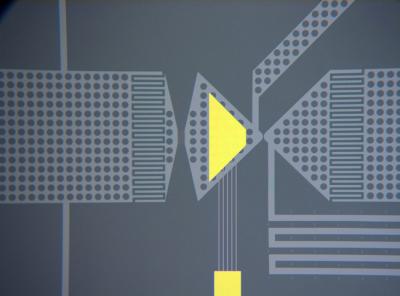New instrument detects individual nanoparticles
March 7, 2011

Optical microscope image of the microfluidic channel (light pattern) and sensing electrode (gold) of the analyzer. Nanoparticles are suspended in a fluid flow through the channel, and are detected individually as they pass through the sensing volume. Graphic: J.L. Fraikin and A.N. Cleland, UCSB
A UCSB research team has developed a new instrument capable of detecting individual nanoparticles with diameters as small as a few tens of nanometers.
The device detects tiny particles suspended in fluid as they flow one by one through the instrument at rates estimated to be as high as half a million particles per second. The researchers showed that the instrument could detect bacterial virus particles.
Applications include water analysis, pharmaceutical development, and other biomedical areas.
Adapted from materials provided by University of California – Santa Barbara